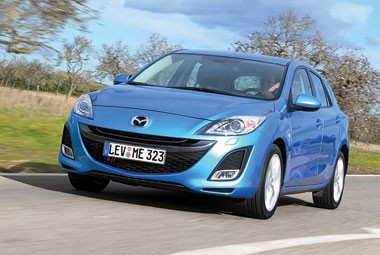Review
Mazda has enjoyed considerable success in the UK fleet market with its 6 upper-medium model (most notably being named best large family car at last month’s Fleet News Awards), and it is now hoping that some of that magic will rub off on its smaller stablemate.
The new Mazda3, on sale in the UK in May, not only shares the family face of the 6 but also technology under the skin, including two new diesel engines.
Truth be told, it will need as much of the 6’s magic as possible because the 3 has always been overshadowed in the lower-medium sector by the Focus/Golf/Astra hegemony.
What the new model, available in saloon and five-door hatchback format, brings is not only sharper styling and a more involving drive, but also improved fuel economy and lower CO2 emissions.
Mark Cameron, sales and marketing director at Mazda UK, said: “Fleet customers will benefit from the dramatic CO2 reductions we have achieved to bring models below the 120 and 160g/km tax thresholds.
“The 1.6-litre petrol’s CO2 has been reduced from 162 to 149g/km, while the new 1.6-litre diesel is now just 119g/km, down from 128.”
When deliveries begin next month, there will be a choice of two petrol engines (1.6 with 105bhp and 2.0 with 150bhp) and three diesels – the 1.6 with 109bhp and two 2.2-litre units borrowed from the Mazda6 offering either 150 or 185bhp.
Later in the year a turbocharged 2.3-litre 260bhp petrol model arrives, badged MPS and intended to be the flagship model
At the same time, a 2.0-litre petrol fitted with a stop-start system will arrive, promising fuel economy gains of up to 14%.
Mazda has also worked hard on making the 3 more refined, notably through using thicker components in the engine bay to reduce vibration and noise intrusion.
Safety benefits include the standard fitment of DSC stability control and an ‘emergency stop signalling system’ which activates the hazard warning lights when sensors detect emergency braking – thus providing more warning to vehicles behind and reducing the chances of a rear-end shunt.
There’s also the option of a ‘rear vehicle monitor’ – essentially a blind spot warning system.
Standard equipment is strong across the range with entry-level S models offering six airbags, air conditioning and an MP3-compatible stereo.
TS adds 15-inch alloy wheels, dual-zone climate control and electric rear windows. TS2 gains larger alloys, automatic headlights and windscreen wipers, heated front seats, cruise control and Bluetooth telephony.
Topping the range is the Sport which includes a sports styling kit as standard which brings new front and rear bumpers, side skirts and a rear spoiler.
Inside, the 3 follows the 6 closely with a neat centre console unit housing the heating and stereo functions.
Less successful is the digital display screen sited on top of the dashboard in an extension of the instrument binnacle.
This houses the stereo and climate control details and, if specified, the satellite navigation screen, but both are too far away from the driver – as a result you struggle to read the sat-nav map.
But other than this the interior is excellent, with plenty of room for adults to sit comfortably in the rear, high-quality materials used and an airy feel thanks to the large glass area.
On the road it is also impressive with a comfortable ride, solid handling and low levels of noise intrusion.
The 1.6-litre diesel certainly feels only 109bhp strong, but once up to cruising speed it settles down into a relaxed gait.
The other engine available to drive at the launch couldn’t be more different.
The 185bhp diesel is an impressive unit, and in the 3 it gives it such strong performance.
It pulls from low revs no matter what gear you are in, and the mid-range punch is astonishing.
Mazda expects to sell around 12,000 units in a full year – slightly up on the 11,000 the old model achieved.
However, fleet registrations will now account for 40% of sales thanks to the lower-emission engines, compared to around 10 to 20% in the previous version.
Expect the range to cost between £13,000 and £22,000.
Verdict
More modern styling, an improved drive and engines offering lower CO2 emissions make the Mazda3 an appealing prospect for drivers who don’t want to opt for the usual models in this sector.
The 1.6-litre diesel with 119g/km makes perfect financial sense.
















